
A railway town, or railroad town, is a settlement that originated or was greatly developed because of a railway station or junction at its site.

A railway town, or railroad town, is a settlement that originated or was greatly developed because of a railway station or junction at its site.
During the construction of the First transcontinental railroad in the 1860s, temporary, "Hell on wheels" towns, made mostly of canvas tents, accompanied the Union Pacific Railroad as construction headed west. Most faded away but some became permanent settlements. [1]

In the 1870s successive boomtowns sprung up in Kansas, each prospering for a year or two as a railhead, and withering when the rail line extended further west and created a new endpoint for the Chisholm Trail.
Becoming rail hubs made Chicago and Los Angeles grow from small towns to large cities.
Sayre, Pennsylvania and Atlanta, Georgia were among the American company towns created by railroads in places where no settlement already existed.
In western Canada, railway towns became associated with brothels and prostitution, and concerned railway companies started a series of YMCAs in the late nineteenth century in response. [2]
In some cases, a railroad town would be started by the railroad, often using a separate town or land company, even when another town already existed nearby. The population of the existing town would shift to the railroad town. This would create a boon for the town company and its railroad founder, which would sell off lots near the station at a substantial profit, often before the railroad ever arrived at the new townsite.
Such is the case with Durango, Colorado. In the spring of 1880, William Bell of the Denver & Rio Grande Railroad scoured the La Plata County area in the vicinity of Animas City, located on the Animas River. When negotiations to acquire land through the local homesteaders fell through, Bell acquired property downstream to the south under more favorable conditions in the name of the Durango Land and Coal Company. By the end of the year, a Durango newspaper reported all of "Animas City is coming to Durango as fast as accommodations can be secured". [3] The population, at the time estimated between 3,000 and 5,000 people, crammed into the little "box town", where the only permanent structures were saloons, dance halls, restaurants and stores.
When the railroad arrived in August 1881, the train stopped in a jubilant Durango, not Animas City. The railroad pushed on up the Animas River, reaching Silverton in July 1882, [3] passing through Animas City without a stop. Animas City subsisted as a de facto suburb of the Durango area before annexation by Durango in 1948. [4] The Durango and Silverton Narrow Gauge Railroad, a heritage railroad and successor to the Rio Grande in La Plata County, still passes by the townsite.
In Denmark, Sweden and Norway, a related concept is the stationsby or "station town". Stationsbyer are rural towns that grew up around railways, but they were based on agricultural co-operatives and artisan communities rather than on railway industries. [5] [6] Among the Swedish towns mostly influenced by railways include Alvesta as a hub for the inland south and Hallsberg as a hub for the interior middle of the country. For Norway, towns such as Bryne on the west coast, Lillestrøm and Ås in the east and south of Oslo are good examples.
In Victorian Britain, the spread of railways greatly affected the fate of many small towns. Peterborough and Swindon became successful due to their status as railway towns; in contrast, towns such as Frome or Kendal remained small after being bypassed by main lines. [7] Some entirely new towns grew up around railway works. Middlesbrough was the first new town to be developed due to the railways, growing from a hamlet of 40 into an industrial port after the Stockton and Darlington Railway was extended in 1830. [8] Wolverton was fields before 1838 and had a population of 1,500 by 1844. [9] Other examples of early railway towns include Ashford (Kent), Doncaster, Neasden and Rugby. [10] Derby came to be dominated, first by the North Midland Railway, and later the Midland Railway, which based all their engineering works, as well as their company headquarters, in the town; a large area of the town was built by the company architect, Francis Thompson. [11]
Crewe grew greatly after the Grand Junction Railway Company moved there in 1843; the two rural towns that became Crewe had a population of 500 in 1841 and the population had reached more than 40,000 by 1900. [9] [12] The railway town of 'New Swindon' displaced the neighbouring pre-existing town after the Great Western Railway moved there; a market town of 2,000 in 1840 became a railway town of 50,000 in 1905. [9] [10] Railways became major employers, with 6,000 people employed by them in Crewe in 1877 and 14,000 in Swindon in 1905. [7]
The growth of railway towns was often in the mould of the 'paternalistic employer' providing housing, schools, hospitals, churches and civic buildings for their workers, similar to Cadbury's Bournville; [10] [13] there was a "very rigid and unimaginative control" of the workers by GWR in Swindon. [10] Workforces were loyal and obedient; industrial action in railway towns was rare because the workforce depended on the company. Railwaymen dominated local politics in railway towns, particularly Francis Webb's 'Independent Railway Company Party' in Crewe and George Leeman in York. The chief mechanical engineer of GWR, Daniel Gooch, was MP for Swindon for twenty years. [13]
Crewe was a 'company town' for its first few decades as workers moved in their thousands from other parts of the country. Most social amenities and organisations were sponsored by the railway, but moves such as the establishment of a town council in 1877 slowly reduced company influence and the railway company began to consider spending on town amenities as a municipal concern. [12] Workers organised their own institutions such as clubs, trade unions and co-operatives to gain independence from company control; they became the basis for political opposition in railway towns. [13]
Railway towns due to traffic junctions are Aulendorf, Bebra, Betzdorf, Buchloe, Falkenberg/Elster, Freilassing, Hagen, Hamm, Lehrte, Offenburg, Plattling and Treuchtlingen. Railway towns as locations of depots for pusher locomotives at the foot of gradient lines are Altenhundem or Neuenmarkt. Railway towns with large border stations are Freilassing or Weil am Rhein.
Knittelfeld is a railway town based on main workshops, with the Austrian Federal Railways as by far the largest employer. Arnoldstein was once an important border station to Italy.
Examples in Switzerland are Olten or as the location of a railway depot for push locomotives Erstfeld. One place with a large border station is Chiasso.
Examples of railway cities in France are Tergnier and Miramas. Examples of a railway town by its border station is Cerbère, where the tracks of the Spanish broad gauge end.
In Belgium, the town of Montzen is of outstanding importance in railway transport.
As of 2021 Lithuanian census, 8 settlements in Lithuania have the legal clasification of a Railway Station, with the largest of them being Panemunėlis (Railway Station) , which is larger than the nearby town of Panemunėlis.
With its marshalling yard and other railway facilities on the international Brussels/Amsterdam-Luxembourg-Metz line, Bettemburg has gained great importance in transit traffic through Luxembourg.
After World War I, the city of Bentschen (today Zbąszyń) was ceded by Weimar Germany to Poland. Subsequently, the German Reichsbahn established the station Neu Bentschen, which functions as a border station and as a junction for three lines leading to the west. Since there was no larger town near the new station, the Deutsche Reichsbahn had a railway settlement built, which subsequently grew into a town. It was given the name Neu Bentschen (today Zbąszynek).
An example of a railway town in Portugal is Entroncamento.
Simeria in Romania grew into a city through new railway facilities.
After the First World War, the Austro-Hungarian Monarchy disintegrated and the state of Czechoslovakia was created. In 1920, Czechoslovakia was granted some areas of Austria close to the border, including the railway station of the Lower Austrian town of Gmünd with the surrounding district. From this the new town České Velenice developed. The reason for drawing the border was the meeting of the railway lines to Ceské Budejovice and Prague in České Velenice.
Zhuzhou used to be a small town that sits next to the Xiang River in Hunan. The mining of Anyuan Coal Mines in Pingxiang, Jiangxi requires a rail line to transport the coals out of the coalfields and Zhuzhou became the destination. The railway transformed Zhuzhou into a prosperous industrial city in Hunan Province and one of the most important rail hubs in China. [14]
Changchun in China was built by the Japanese, then occupying Manchuria, as a 'model town' as part of Japan's imperialist modernisation. The first railway town at Changchun was begun by the Russians in 1898, but it excluded Chinese residents. A second major railway town was designed and built from 1905 by the South Manchuria Railway, inspired by Russian railway towns such as Dalian. It was based on a rectangular system that contrasted with the circular walled town of old Changchun, and grid patterns became the standard for Chinese railway towns. The SMR developed dozens of railway towns in north-east China from 1906 to 1936, such as at Harbin and Mukden. [15] [16]
Daejeon City in South Korea was a small village before the 1900s, the construction of Gyeongbu Line and Honam Line, and the subsequent transfer of the provincial capital from historic city of Gongju made Daejeon grew into a major transportation hub in Korea. Korail's headquarters is located in Daejeon.
When the Trans-Australian Railway was built across the Nullarbor Plain in the 1910s, a series of towns were erected in South Australia and Western Australia to accommodate Commonwealth Railways' employees. [17] To provide supplies the Tea & Sugar train ran weekly. [18]

Durango is a home rule municipality that is the county seat and the most populous municipality of La Plata County, Colorado, United States. The city population was 19,071 at the 2020 United States Census. Durango is the home of Fort Lewis College.

Crewe is a railway town and civil parish in the unitary authority of Cheshire East in Cheshire, England. The civil parish of Crewe had a population of 55,318 in the 2021 census. The larger Crewe built-up area, which also covers parts of the adjacent civil parishes of Willaston, Shavington cum Gresty and Wistaston, had a total population of 76,437 in 2021.

Changchun is the capital and largest city of Jilin Province in China. Lying in the center of the Songliao Plain, Changchun is administered as a sub-provincial city, comprising 7 districts, 1 county and 3 county-level cities. According to the 2020 census of China, Changchun had a total population of 9,066,906 under its jurisdiction. The city's metro area, comprising 5 districts and 1 development area, had a population of 5,019,477 in 2020, as the Shuangyang and Jiutai districts are not urbanized yet. It is one of the biggest cities in Northeast China, along with Shenyang, Dalian and Harbin.

The South Manchuria Railway, officially The South Manchuria Railway Company, Ltd., Mantetsu or Mantie for short, was a large National Policy Company of the Empire of Japan whose primary function was the operation of railways on the Dalian–Fengtian (Mukden)–Changchun corridor in northeastern China, as well as on several branch lines.

Crewe railway station serves the railway town of Crewe, in Cheshire, England. It opened in 1837 and is one of the most historically significant railway stations in the world.

The Chinese Eastern Railway or CER, is the historical name for a railway system in Northeast China.
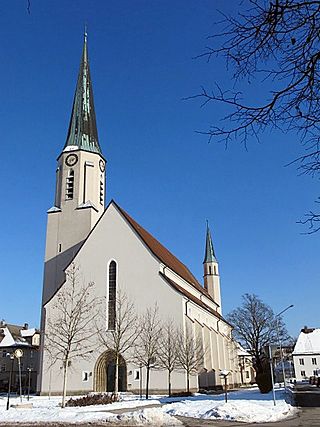
Freilassing, until 1923 Salzburghofen is a town of some 16,000 inhabitants in the southeastern corner of Bavaria, Germany. It belongs to the "Regierungsbezirk" Oberbayern and the "Landkreis" (County) of Berchtesgadener Land. Located very close to the German-Austrian border, Freilassing can be seen as the biggest satellite of Salzburg, the centre of which is eight kilometres away, on the other side of the border.
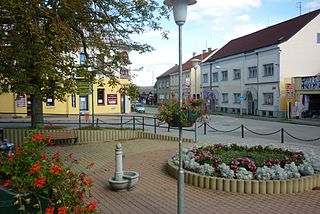
České Velenice is a town in Jindřichův Hradec District in the South Bohemian Region of the Czech Republic. It has about 3,600 inhabitants. It lies on the border with Austria and is adjacent to the town of Gmünd, to which it once belonged.

Zhuzhou, formerly Jianning (建宁), is a prefecture-level city of Hunan Province, China, straddling the Xiang River southeast of the provincial capital, Changsha, and bordering Jiangxi province to the east. It is part of the "Greater Changsha Metropolitan Region, also known as Changzhutan Golden Triangle". The city has jurisdiction over five counties and four districts, and covers an area of 11,420 km2 (4,410 sq mi).

The Emperor Franz Joseph Railway was an Austrian private railway company, named after Emperor Franz Joseph I. It operated railway lines from the Austrian capital Vienna to Prague and Eger (Cheb) in Bohemia.

Baicheng is a prefecture-level city in the northwestern part of Jilin province, People's Republic of China, bordering Inner Mongolia to the north and west and Heilongjiang to the east and northeast. At the 2010 census, 2,033,058 people lived within its administrative area of 25,683 km2 (9,916 sq mi).
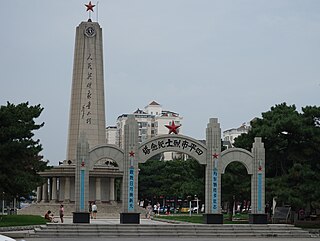
Siping, formerly Sipingjie, is a prefecture-level city in the west of Jilin province, People's Republic of China. It has a total population of 1,814,733 inhabitants, as of the 2020 census. Siping covers an area of 14,323 km2 (5,530 sq mi) and is located in the middle of the Songliao Plain, near the border with Liaoning and Inner Mongolia provinces.

The Durango and Silverton Narrow Gauge Railroad, often abbreviated as the D&SNG, is a 3 ft (914 mm) narrow-gauge heritage railroad that operates on 45.2 mi (72.7 km) of track between Durango and Silverton, in the U.S. state of Colorado. The railway is a federally-designated National Historic Landmark and was also designated by the American Society of Civil Engineers as a National Historic Civil Engineering Landmark in 1968.
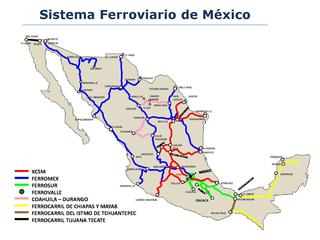
Mexico has a freight railway system owned by the national government and operated by various entities under concessions (charters) granted by the national government. The railway system provides freight and passenger service throughout the country, connecting major industrial centers with ports and with rail connections at the United States border. Passenger rail services were limited to a number of tourist trains between 1997, when Ferrocarriles Nacionales de México suspended service, and 2008, when Ferrocarril Suburbano de la Zona Metropolitana de México inaugurated Mexico's first commuter rail service between Mexico City and the State of Mexico. This is not including the Mexico City Metro, which started service in 1969.

Zbąszynek is a town in western Poland, in Lubusz Voivodeship, in Świebodzin County. As of 2019, it has 5,020 inhabitants. It is located within the historic region of Greater Poland.

Kuancheng District is one of seven districts of the prefecture-level city of Changchun, the capital of Jilin Province, Northeast China. It is part of Changchun's main urban area, located north of downtown. It borders Dehui to the northeast, Jiutai to the east, Erdao District to the southeast, Nanguan and Chaoyang Districts to the south, Luyuan District to the southwest, and Nong'an County to the northwest.
The Rosenheim–Salzburg railway is a continuous double track and electrified main line railway almost entirely within the German state of Bavaria. It is an international transport corridor, linking Rosenheim to Salzburg in Austria.

Freilassing station is located in the Upper Bavarian district of Berchtesgaden. It is the last German station on the railway line from Munich to Salzburg, a border station to Austria and the only station in the town of Freilassing.
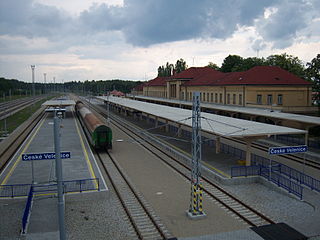
České Velenice is a border train station in the western part of České Velenice in South Bohemian Region of the Czech Republic. It lies on the electrified track České Budějovice–Gmünd (199) and also not-electrified track České Velenice–Veselí nad Lužnicí (226).